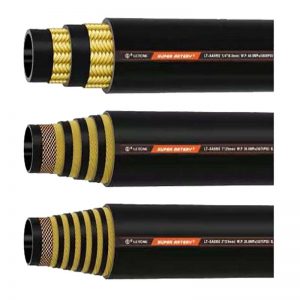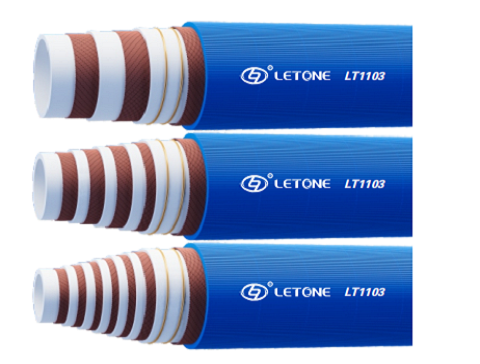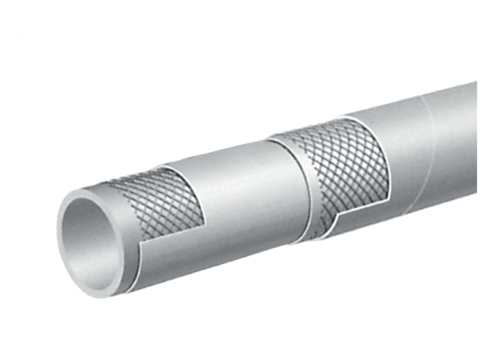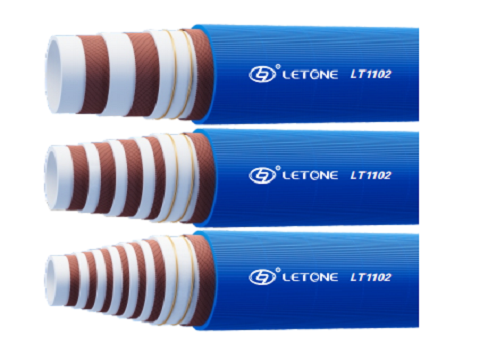In modern industrial fields and daily life, hoses are indispensable and important components. There are various types of hoses with a wide range of applications. Among them, braided hoses and flexible hoses have received widespread attention. However, for many people, these two terms may seem unfamiliar and sometimes even confused. This article will delve into what braided hoses and flexible hoses are, and analyze in detail their differences and respective application scenarios.
What is a braided hose?
Braided hoses usually refer to hoses that are wrapped in one or more layers of woven fabric on the outer layer of the hose. These woven fabrics can be made of metal wire, stainless steel wire, nylon fiber, or other high-strength materials. This design not only enhances the compression resistance and mechanical strength of the hose, but also greatly improves its wear resistance and service life.
Materials and functions of woven layers
1. Metal braided layer: Common materials include stainless steel wire, galvanized steel wire, etc. Metal braided hoses are suitable for high-pressure environments, capable of withstanding extreme external pressure and impact, and also have excellent high temperature resistance.
2. Nylon woven layer: Nylon fibers have excellent wear resistance and tensile strength. Nylon braided hoses are relatively more flexible and suitable for medium and low pressure environments, and are widely used in fields such as home and vehicle maintenance.
 3. Glass fiber woven layer: Glass fiber is an inorganic non-metallic material with good insulation and corrosion resistance. Fiberglass braided hoses are suitable for use in high temperature and chemical environments.
Application of woven hoses
Due to its high pressure resistance and high wear characteristics, braided hoses are widely used in industries such as chemical, petroleum, and aerospace. For example, high-pressure steam pipes, hydraulic system pipelines, and automotive engine coolant pipes are typical applications of braided hoses.
What is a flexible hose?
Flexible hoses, as the name suggests, are characterized by high flexibility and flexibility. In many situations where frequent movement or limited installation space is required, flexible hoses can play an irreplaceable role.
Materials and functions of flexible hoses
There are various materials for flexible hoses, usually including rubber, etc. Due to different materials, the performance of flexible hoses varies.
1. Rubber flexible hose: Rubber material has good fatigue resistance and elasticity, suitable for use in mechanical equipment or vehicles with high vibration.
2. Metal flexible hose: This type of hose is commonly made of stainless steel or galvanized steel and has excellent high temperature and pressure resistance, suitable for high temperature and high pressure environments.
Application of flexible hoses
Flexible hoses are widely used in various fields such as mechanical equipment, household appliances, water conservancy engineering, and municipal construction due to their easy bending and convenient installation. For example, refrigerant delivery pipes in air conditioning systems, inlet and outlet pipes in sanitary equipment, gas and liquid delivery pipes in industrial equipment, etc.
The main difference between braided hoses and flexible hoses
Although braided hoses and flexible hoses may seem interchangeable in certain application environments, there are many significant differences between the two in terms of structure, performance, and typical application scenarios.
1. Different structures: Woven hoses are wrapped in one or more layers of woven fabric on the outer layer of traditional hoses, making their structure more complex and having higher mechanical strength. In contrast, flexible hose structures are relatively simple, mainly based on the flexibility of the material itself, and usually do not have additional weaving layers.
2. Performance difference: Braided hoses mainly emphasize high pressure and wear resistance, while flexible hoses pay more attention to bending and flexibility. Therefore, braided hoses are suitable for high-pressure environments, while flexible hoses are more suitable for applications that require flexible bending.
3. Material selection: There are various materials for the weaving layer of braided hoses, usually using high-strength metal or fiber materials, while the material of flexible hoses mainly focuses on flexibility such as rubber.
4. Application areas: Braided hoses are commonly used in demanding environments such as industry and high-pressure liquid transportation, while flexible hoses are more commonly found in urban construction, household use, and vehicle maintenance.
How to choose the appropriate hose?
Choosing the appropriate hose requires comprehensive consideration based on the specific usage environment and requirements. The following aspects can be used as references:
1. Pressure requirements: If the application environment requires high pressure, braided hoses are preferred. If the pressure requirement is not high but a larger bending radius is needed, flexible hoses are preferred.
2. Temperature conditions: Consider the ambient temperature of the hose during use. Braided metal hoses and flexible rubber hoses are suitable for high temperature environments
3. Chemical corrosiveness: Select appropriate materials based on the chemical properties of the conveying medium. For example, if corrosive liquids need to be transported, fluororubber flexible hoses are a better choice, while ordinary rubber hoses may not be suitable.
4. Mechanical performance: Consider the wear and fatigue resistance of the hose, and select the appropriate product based on the frequency and strength of use.
Future Development Trends
With the continuous advancement of technology and industry, the research and application of hoses are also constantly developing. In the future, we can look forward to the emergence of hose products with higher performance, longer lifespan, and multifunctionality. For example, the application of new composite materials may bring higher performance braided hoses, while intelligent flexible hoses may be able to detect and adjust the conveying status on their own.
In summary, braided hoses and flexible hoses have significant advantages and irreplaceable positions in their respective application fields. Understanding and selecting the appropriate hose can not only improve work efficiency, but also extend the service life of equipment and ensure safe production.
Both braided hoses and flexible hoses have their own advantages, and it is particularly important to choose the appropriate type of hose based on specific needs and application environments.
3. Glass fiber woven layer: Glass fiber is an inorganic non-metallic material with good insulation and corrosion resistance. Fiberglass braided hoses are suitable for use in high temperature and chemical environments.
Application of woven hoses
Due to its high pressure resistance and high wear characteristics, braided hoses are widely used in industries such as chemical, petroleum, and aerospace. For example, high-pressure steam pipes, hydraulic system pipelines, and automotive engine coolant pipes are typical applications of braided hoses.
What is a flexible hose?
Flexible hoses, as the name suggests, are characterized by high flexibility and flexibility. In many situations where frequent movement or limited installation space is required, flexible hoses can play an irreplaceable role.
Materials and functions of flexible hoses
There are various materials for flexible hoses, usually including rubber, etc. Due to different materials, the performance of flexible hoses varies.
1. Rubber flexible hose: Rubber material has good fatigue resistance and elasticity, suitable for use in mechanical equipment or vehicles with high vibration.
2. Metal flexible hose: This type of hose is commonly made of stainless steel or galvanized steel and has excellent high temperature and pressure resistance, suitable for high temperature and high pressure environments.
Application of flexible hoses
Flexible hoses are widely used in various fields such as mechanical equipment, household appliances, water conservancy engineering, and municipal construction due to their easy bending and convenient installation. For example, refrigerant delivery pipes in air conditioning systems, inlet and outlet pipes in sanitary equipment, gas and liquid delivery pipes in industrial equipment, etc.
The main difference between braided hoses and flexible hoses
Although braided hoses and flexible hoses may seem interchangeable in certain application environments, there are many significant differences between the two in terms of structure, performance, and typical application scenarios.
1. Different structures: Woven hoses are wrapped in one or more layers of woven fabric on the outer layer of traditional hoses, making their structure more complex and having higher mechanical strength. In contrast, flexible hose structures are relatively simple, mainly based on the flexibility of the material itself, and usually do not have additional weaving layers.
2. Performance difference: Braided hoses mainly emphasize high pressure and wear resistance, while flexible hoses pay more attention to bending and flexibility. Therefore, braided hoses are suitable for high-pressure environments, while flexible hoses are more suitable for applications that require flexible bending.
3. Material selection: There are various materials for the weaving layer of braided hoses, usually using high-strength metal or fiber materials, while the material of flexible hoses mainly focuses on flexibility such as rubber.
4. Application areas: Braided hoses are commonly used in demanding environments such as industry and high-pressure liquid transportation, while flexible hoses are more commonly found in urban construction, household use, and vehicle maintenance.
How to choose the appropriate hose?
Choosing the appropriate hose requires comprehensive consideration based on the specific usage environment and requirements. The following aspects can be used as references:
1. Pressure requirements: If the application environment requires high pressure, braided hoses are preferred. If the pressure requirement is not high but a larger bending radius is needed, flexible hoses are preferred.
2. Temperature conditions: Consider the ambient temperature of the hose during use. Braided metal hoses and flexible rubber hoses are suitable for high temperature environments
3. Chemical corrosiveness: Select appropriate materials based on the chemical properties of the conveying medium. For example, if corrosive liquids need to be transported, fluororubber flexible hoses are a better choice, while ordinary rubber hoses may not be suitable.
4. Mechanical performance: Consider the wear and fatigue resistance of the hose, and select the appropriate product based on the frequency and strength of use.
Future Development Trends
With the continuous advancement of technology and industry, the research and application of hoses are also constantly developing. In the future, we can look forward to the emergence of hose products with higher performance, longer lifespan, and multifunctionality. For example, the application of new composite materials may bring higher performance braided hoses, while intelligent flexible hoses may be able to detect and adjust the conveying status on their own.
In summary, braided hoses and flexible hoses have significant advantages and irreplaceable positions in their respective application fields. Understanding and selecting the appropriate hose can not only improve work efficiency, but also extend the service life of equipment and ensure safe production.
Both braided hoses and flexible hoses have their own advantages, and it is particularly important to choose the appropriate type of hose based on specific needs and application environments.







